by Admin Mediterra | Sep 26, 2020 | Synchronization
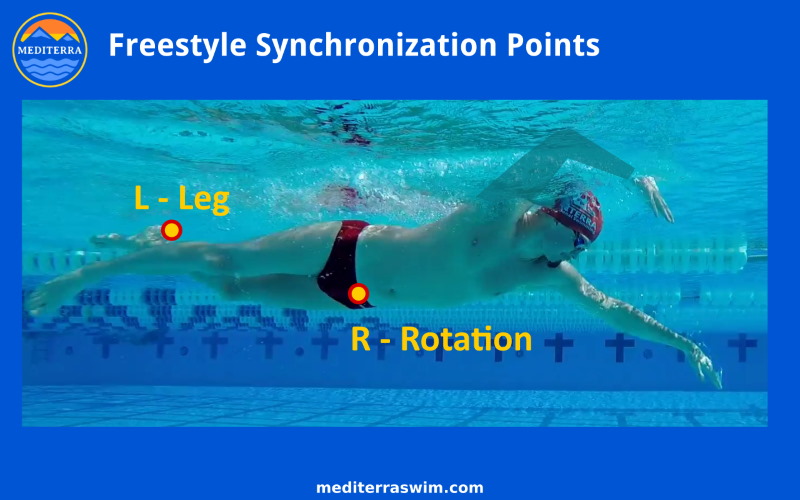
You can begin to synchronize the leg press with the rotation once you have the arms synchronized in front, because the leg motion is ultimately going to connect to the arms through the torso. Without that timing in front, the legs will have a hard time finding the 2BP rhythm in the rear. But before you connect those distant points, you will first work on connecting the press of the leg with the rotation.
Before the rotation, you may appreciate how the foot has been positioned in the Counter-Balanced Leg Position, poised, ready to press. Notice in the image above how the Streamline side of the body is down, while the Streamline side heel is up, near the surface. The raised position of the streamline side leg and the downward pointing leg of the other side are counter-balancing the body’s rotated position in front. The leg is ready to push downward so that the Streamline side of the body can rotate upward. The press of the leg offers support, it offers leverage to help the rotation go with a bit more power.
As with the fine tuning of the arm overlap, the timing of the leg has a little room for adjustment according to the tempo of the stroke. At slower tempos, the leg will press a moment after the torso has begun to rotate. At slower tempos, the press of the leg feels like it is helping to finish the rotation. At very fast tempos, the leg will press at the same moment the torso begins to rotate. In this case, it may feel like the press of the leg is helping to start the torso rotation. This is very helpful when working at sprinting tempos, where it is harder to keep the torso rotating back and forth to keep up with the demanding tempo.
Instructions

Step 1: Down-Up Leg-Torso Connection
Use the press of the leg to help rotate the same side of the torso upward toward the surface. The leg is moving down and the side is moving up in response. This is the simple down-up connection. Notice in the image above, how the foot is now down and the hip of the same side is on its way up toward the surface.
And, it will be helpful to practice working just one leg, one side repetitiously. Remember that the 2BP is just one foot pressing in one arcing path. The other foot is not pulling, it is just drifting back in the opposite direction. So practice working just one leg at a time, over and over again, while the other practices holding pointed toes.
Step 2: Use Hip Torque
As instructed in our Intro to the 2 Beat Leg Press, now notice how the turn of the ankle corresponds to the turn of the rotation. Rather than bending the knee and pushing with the thigh, keep the knee fairly straight (allow the slightest flex) and twist your ankle in order to activate torque in the hip socket. Create that ‘Crescent Moon’ pathway with your toes. This is the more effective way to direct the press of the leg. By arcing the toes from ‘pigeon toe’ inward to ‘toes outward’ this action torques the hip joint, urging the whole torso to rotate with it. This is how you genuinely generate a ‘hip-driven’ kick. Use the torque of the muscles surrounding the hip joint, rather than pressing downward with the thigh muscles as you would with a normal flutter kick.
Review the 2BP drill videos in the Knowledge Base to tune up how you perform the kick action.
Step 3: Refine The Timing Per Tempo
Since each swimmer’s functional tempo range is a bit different from any other’s, you will need to do some experimenting to set the best timing of the press to match each tempo zone (slow, medium, brisk) you work in.
For your slower comfortable tempos, let the press of the leg lag slightly behind the start of the rotation.
For your fastest tempos, let the press of the leg start immediately with the start of the rotation.
And for your medium tempos, let the press of the leg start somewhere in between.
Step 4: Refine The Pressure
It is tempting to kick abruptly or ‘snap’ the kick, but resist this. When you understand how the press of the leg is suppose to enhance the rotation, then you need to slow down that press and make the pressure steady and continuous as possible during the time taken by the rotation. Try to make the press of the leg last longer, to support the rotation longer.
Match the rate of speed of the leg press to the rate of speed of the rotation. It won’t be exact – the leg will certainly move a bit faster – but aim for this match as much as possible. If the leg snaps too quickly, it sends a wave of force that can’t be fully absorbed into the rotation, and this becomes another form of ‘power leakage’.
by Admin Mediterra | Sep 24, 2020 | Synchronization
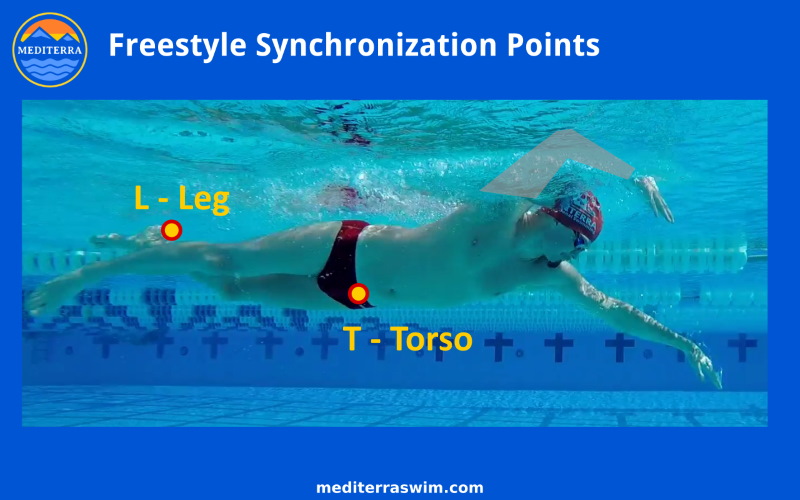
Once you have practiced the LT (leg-torso) synchronization, and the ET (entry-torso) synchronization, then it is just a blending of both of those to create the LE synchronization. However, this is moving across the body, from one extreme end to the other. It can be the most difficult connection to make, but once you do, it is the most pleasing one!
Once again, you are ‘zooming out’ to take in the full body, from foot on one side to wrist on the other, to feel the connection between these two actions, through the torso. The torso rotation empowers the entry and extension to the target. The press of the leg supports the torso rotation. Therefore, the press of the leg helps empower the extension forward.
This is often the last sync combination to practice because the other synchronization combinations are set up to support this main action of extending farther forward on each stroke. This LE synchronization is what will make your stroke as long as it can be optimally. It is what creates the acceleration you seek on every stroke. So, take the time to establish the other connections, and they will enhance this one.
Instructions
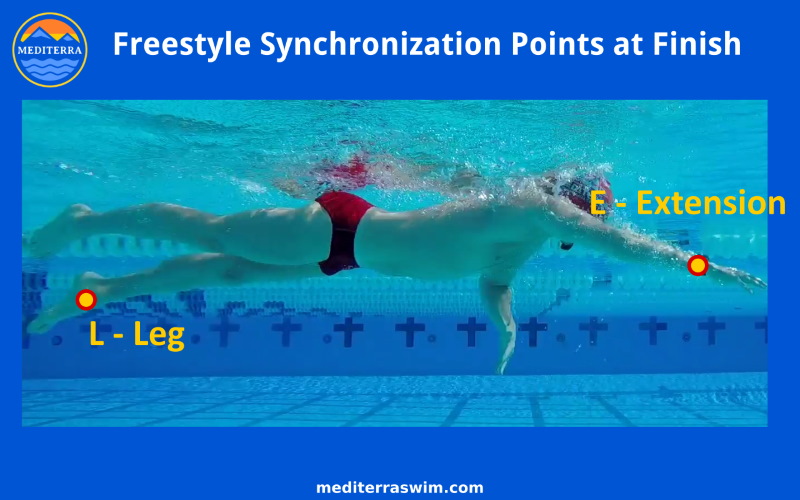
When the leg comes down to its finish position the entry arm is sliding into streamline position.
Just as you practiced pressing the leg more slowly, with a steady pressure to match the torso rotation, aim to match the pressure and rate of speed of the extension also. As noted previously, it is tempting to ‘snap’ the foot for an abrupt kick, but this sends a wave of force too quickly forward, before the extending arm is ready to absorb and apply it to extend further. Keep the press of the leg as steady and smooth, matched to the torso rotation, and thereby matched to the entry/extension. The more closely these two are matched and kept proportional in speed, the more the press of the leg can assist that extension, the more you can feel it assisting. The leg will move faster and get to its finish position before the extension finishes, but aim to make that press last longer.
There is some room to adjust the timing of the press to the tempo. At slower tempos, have the press of the leg come about half way into the entry, with the intent to use the press to help finish the extension to the target. At very fast (sprinting) tempos, it may be more helpful to have the press of the leg come right as the hand is entering in order to drive it more powerfully and more quickly to the target, since the fast tempo allows so little time to get there through the water resistance ahead.
Remember to keep all actions smooth no matter how much force is involved. You can be powerful, but in water, power must be applied smoothly, gradually building up, in order to create a more uniform (less turbulent) displacement of water molecules. Smooth actions keep drag to a minimum. As Coach Mat says sometimes, “Make the action like you are cutting butter, not like pounding meat.”
And, when you are feeling fatigued, or still have a long way to swim, this can be one of the more endurance-promoting focal points you can use. The default land-mammal reaction to fatigue is to start pulling back harder on the water. Resist this urge. Instead, put your dwindling resources into protecting this Send-Force-Forward emphasis in your stroke. Under fatigue, it will do more to reduce your loss of speed and extend your energy than just about any other emphasis.
by Admin Mediterra | Sep 24, 2020 | Synchronization
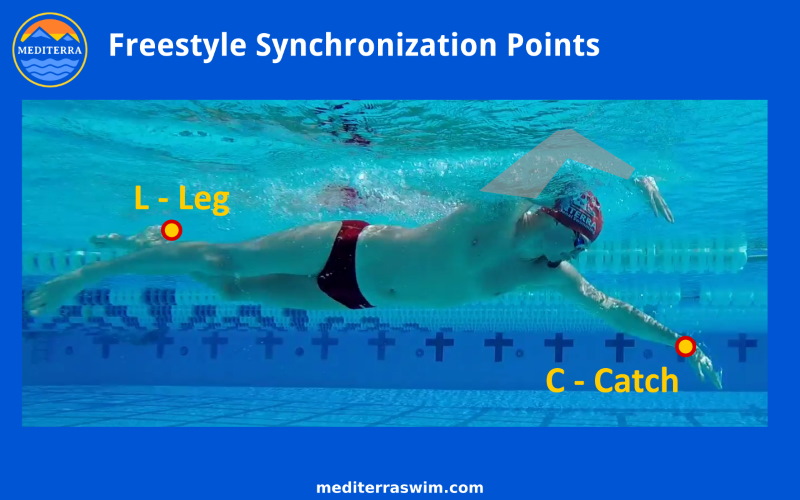
Once you have practiced the LT (leg-torso) synchronization, and the CT (catch-torso) synchronization, then it is just a blending of both of those to create the LC synchronization.
You are ‘zooming out’ to take in the full side of the body, from foot to forearm, to feel the connection between these two actions, through the torso. The torso rotation empowers the catch. The press of the leg supports the torso rotation. Therefore, the press of the leg helps empower the catch.
Instructions
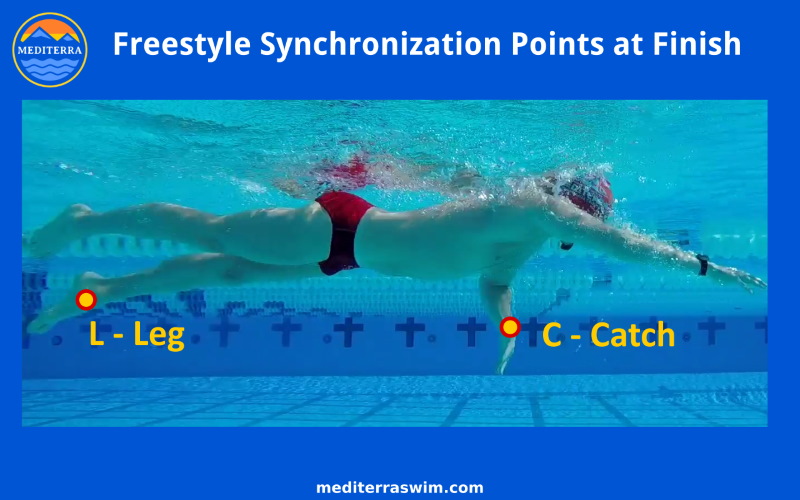
The leg will come down to its finish position as the catch is moving through its phase.
Just as you practiced pressing the leg more slowly, with a steady pressure to match the torso rotation, aim to match the pressure and rate of speed of the catch also. The more closely these two are matched and kept proportional in speed, the more the press of the leg can assist that catch, the more you can feel it assisting. The leg will move faster and get to its finish position before the catch finishes, but aim to make that press last longer.
This can be particularly useful and encouraging when you are starting to feel muscle fatigue in the catch, yet are pushing yourself to maintain steady SPL and/or tempo. Focusing on the connection between the leg and the catch can help ‘lighten the load’ on that catch action, enabling you to persist at the same effort a bit longer.
Keep a close eye on the shape and pathway of your catch so that you are maintaining your best grip on the water. The better your catch the more you will feel the press contributing toward making it easier.
by Admin Mediterra | Sep 24, 2020 | Synchronization
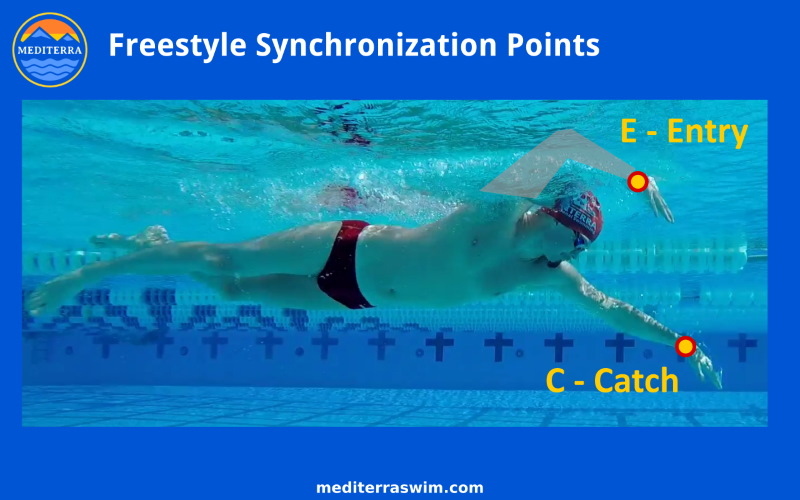
There is an ideal timing for the switch of the arms in front of the body. In the image above you can see the entry hand (E) piercing the water just across from the elbow of the lead arm. This is about the ideal moment for the arms to switch positions. Now the lead arm can begin the catch (C).
Just before this moment, the lead arm continues to extend forward while waiting for the recovery arm to come fully forward. Note that the lead arm is not passively hanging there – that side of the body is actively stretching the whole time. The streamline side of the body feels long and firm and getting longer.
There is some small room for adjustment depending on the tempo, but in general the ideal timing is to have the catch begin at the moment the entry hand has entered the water. For slower tempos your entry arm might be submerged to past the watch band by the time you set the catch, and for faster tempos your fingers may just start to pierce the water at the time you set the catch. But to switch earlier than this, or later than this is going to introduce greater ‘power leaks into your stroke.
Another way to phrase this is ‘arm overlap’. Notice how far the entry arm overlaps the lead arm in about the ideal amount. If you have too little overlap, or too much overlap at the moment the arms switch, then the catch is not able to connect with the full torso rotation, and ‘power leaks’ from the propulsive action. When there is just the right amount of overlap, then you are able to transfer force from the catch side to the entry side of the body instantaneously, and smoothly. Timing both sides with the full torso rotation is the key.
At the moment your entry hand is piercing the water, your torso begins to rotate. The ideal is to connect the catch to the start of this torso rotation also. Notice how all three must happen together.
Imagine a steel cable tying the catch wrist to the entry wrist. This cable passed through the shoulders. When one wrist moves the other must move in immediate response to it, in one smooth motion. The shoulder connect the two arms. When you set the catch on one side and start to press against the water, you instantly transfer that force – through that imaginary steel cable – into the entry arm. The entry arm slides down and then extends forward, receiving the force from the catch side of the body. This is how you generate and feel acceleration on each stroke. This is where the magic begins.
Instructions
First, in slower motion strokes, establish the ideal timing, or ‘overlap’ position and get very familiar with this.
To make the ideal zone more distinct in your nervous system, occasionally try too much overlap, and too little overlap in order to feel how those distortions cause your stroke to feel less connected, less effective. Notice how you get less acceleration.
Gradually speed up the tempo while maintaining this same ideal overlap. Eventually, you should be able to keep proper switch timing at every tempo you train with, from slow to sprint tempos.
Remember that the motion of the two arms, entry and catch sides, through the shoulders, should feel firmly connected to each other. You are aiming for a immediate, smooth transfer of force from one side of the body to the other, that gives you a sense of acceleration on each stroke.
The better the catch shape and pathway, the more force you generate that is available to be transferred to the other side.
The better your streamline position, the farther your body is able to slide forward once it receives that force.
The better your arm switch timing (the amount of overlap), the more of that force is transferred to the other side.
by Admin Mediterra | Sep 24, 2020 | Synchronization

The Catch (C) and the Rotation (R) (sometimes represented by the Hip), are not often connected in the typical swimmer. This is where one of the biggest power leaks can be plugged.
Again, the rotation – with shoulders and hips tied together into one unit – may be represented by the hip.
Ideally, you will set the catch (initiate the start of the catch) at the moment the hip is beginning to turn. On the same side of the body, the hip will begin rotating upward, and the catch will begin pressing backward. But these can only happen together when the Entry is located and timed first. Remember that the rotation will always wait for the Entry. So if the catch must wait for the torso to turn, that means it must also wait for the Entry to start – then all three will happen together.
If E and C are synchronized first, then and only then can you work on the C and R synchronization. EC must be in place first.
The easiest way to isolate the connection of the Catch and the Rotation is to do a One-Arm Swimming Drill. This drill takes the other arm out of play, so as you move through the stroke cycle with only one arm, you will be forced to use rotation to empower the catch. It should make sense to your body to do it this way when you have only one arm, and it will be obvious how helpful it is to have the torso rotation create the main power of the catch. But the moment you put the other arm back into the choreography, you may notice that your catch no longer automatically connects to the rotation – often it will start pulling way before the torso starts turning! When the catch starts pulling before the rotation, this means that arm must pull with small shoulder muscles the whole way – the small shoulder muscles will tire so much more quickly than the torso muscles will!
You can test the timing of your EC arm switches by doing recovery and entry drills to make sure your entry hand reaches the entry position as the trigger for the catch to begin.
Instructions
The goal is empower most of the catch by the rotation. In other words, you want to shift more of the catch load to the torso (to the side and back of the body) and lighten the load on the smaller shoulder muscles. The sensation you are aiming for is to feel the pressure you apply coming from that side and back of your torso, where you do not feel acutely strained in any small muscles of the shoulder. It will feel easier to maintain a powerful hold on the water when you can hold with the whole side of your body.
Beware: Just because the catch and rotation are happening at the same time does not automatically mean that the loading has been shifted to the torso. You need to feel that you are holding mostly with the slide of the shoulder toward your hip – this will engage your lat muscles which you can feel easily. If you feel more loading in the small pulling muscles around the shoulder and little or no loading on the back and side of your torso, then you have not transferred enough of the load to the torso.
This is easier to notice and improve at slower tempos. Start slowly to tune up this pattern then gradually increase tempo to normal rates as the pattern gets familiar to your nervous system.
It may be helpful to imagine an elastic band connecting your (catch side) wrist to your hip. As the hip rotates upward, it pulls the wrist backward through this imaginary elastic band.
Keep the rate of the hip turn about the same as the rate the catch/hold is pulling back on the water. Do not pull abruptly on the water. Nor should you try to rotate abruptly. You can be powerful, but apply that power gradually, and smoothly.
These two moving parts of the body should feel instantaneously connected in the same unified action, on this side of the body.
Try disconnecting CR and count strokes, then connect CR and count strokes. You should notice a clear difference in SPL between the two.
by Admin Mediterra | Sep 24, 2020 | Synchronization

The Entry/Extension (E) and the Rotation (R) (sometimes represented by the Hip), is the easiest connection to study because on virtually every swimmer the rotation will wait until the recovery arm has come all the way forward and is ready to enter the water. That side of the body is held up in the air by the rotation until the entry arm is ready to slide down into the water. The drop of the shoulder allows the arm to drop into the water. Without even having to think about it, your Entry and Rotation are likely, already approximately synchronized.
This is an automatic pattern that swimmer don’t often notice because it is already happening. But now you are going to pay attention to it because you can make that synchronization even better.
Instructions
At slow and moderate tempos you can allow gravity to initiate your rotation – the high side is being pushed downward, so when the arm swings into entry position, you can just let gravity pull the arm downward and rotation happen together. This is the most economical way to engage rotation power, obviously.
Initially, it can be easier to imagine an line connecting your wrist, arm, shoulder, and side of torso down to the pelvis as one unit that moves together. So, when you examine the connection between the Entry and the Rotation, you can more pay attention to that entire side of the body moving together. These two moving parts of the body should feel instantaneously connected in the same unified action, on this side of the body.
Practice ER where you emphasize using the Rotation to help push the Entry (E) into Extension to the target, as if connected with an extending mechanical rod.
Practice ER where you emphasize using the Extension (E) to pull the torso behind it, as if the wrist and the hip were connected by an elastic band.
Which one creates a more pleasing internal effect for you?
Which one produces a longer stroke (a lower stroke count) for you?
by Admin Mediterra | Sep 24, 2020 | Synchronization
These sets will offer an introduction to how to practice with sync combinations. You may find a whole training plan on this topic in the Master Class Sync course.
Practice Set 1
Swim 4 rounds of 3 cycles (2x 25m), one for each combination of points.
- Round #1 – 2x 25 sync EC, 2x 25 sync ER, 2x 25 sync EL
- Round #2 – 2x 25 sync CE, 2x 25 sync CR, 2x 25 sync CL
- Round #3 – 2x 25 sync RE, 2x 25 sync RC, 2x 25 sync RL
- Round #4 – 2x 25 sync LE, 2x 25 sync LC, 2x 25 sync LR
When you are more acquainted with how this kind of practice works, and when your attention can handle it, select a cue for one or both of those propulsive parts
Practice Set 2
3 rounds of 3x 150 whole stroke.
Using a Tempo Trainer at a comfortable cruising tempo is optional.
- Round #1 – focus on EC
- Round #2 – focus on RC
- Round #3 – focus on ERC









